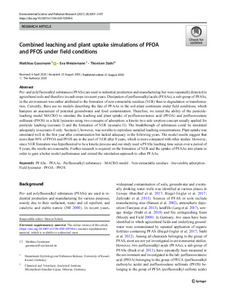| dc.date.accessioned | 2021-01-20T15:10:00Z | |
| dc.date.available | 2021-01-20T15:10:00Z | |
| dc.date.issued | 2020-08-31 | |
| dc.identifier | doi:10.17170/kobra-202101203005 | |
| dc.identifier.uri | http://hdl.handle.net/123456789/12427 | |
| dc.description.sponsorship | Gefördert im Rahmen des Projekts DEAL | ger |
| dc.language.iso | eng | eng |
| dc.rights | Namensnennung 4.0 International | * |
| dc.rights.uri | http://creativecommons.org/licenses/by/4.0/ | * |
| dc.subject | PFASs | eng |
| dc.subject | PFAAs | eng |
| dc.subject | perfluoroalkyl substances | eng |
| dc.subject | MACRO model | eng |
| dc.subject | non-extractable residues | eng |
| dc.subject | irreversible adsorption | eng |
| dc.subject | PFOA | eng |
| dc.subject | PFOS | eng |
| dc.subject.ddc | 540 | |
| dc.subject.ddc | 570 | |
| dc.title | Combined leaching and plant uptake simulations of PFOA and PFOS under field conditions | eng |
| dc.type | Aufsatz | |
| dcterms.abstract | Per- and polyfluoroalkyl substances (PFASs) are used in industrial production and manufacturing but were repeatedly detected in agricultural soils and therefore in cash crops in recent years. Dissipation of perfluoroalkyl acids (PFAAs), a sub-group of PFASs, in the environment was rather attributed to the formation of non-extractable residues (NER) than to degradation or transformation. Currently, there are no models describing the fate of PFAAs in the soil-plant continuum under field conditions, which hampers an assessment of potential groundwater and food contamination. Therefore, we tested the ability of the pesticide-leaching model MACRO to simulate the leaching and plant uptake of perfluorooctanoic acid (PFOA) and perfluorooctane sulfonate (PFOS) in a field lysimeter using two concepts of adsorption: a kinetic two-side sorption concept usually applied for pesticide leaching (scenario I) and the formation of NER (scenario II). The breakthrough of substances could be simulated adequately in scenario II only. Scenario I, however, was not able to reproduce sampled leaching concentrations. Plant uptake was simulated well in the first year after contamination but lacked adequacy in the following years. The model results suggest that more than 90% of PFOA and PFOS are in the pool of NER after 8 years, which is more compared with other studies. However, since NER formation was hypothesized to be a kinetic process and our study used a PFASs leaching time series over a period of 8 years, the results are reasonable. Further research is required on the formation of NER and the uptake of PFAAs into plants in order to gain a better model performance and extend the simulation approach to other PFAAs. | eng |
| dcterms.accessRights | open access | |
| dcterms.creator | Gaßmann, Matthias | |
| dcterms.creator | Weidemann, Eva | |
| dcterms.creator | Stahl, Thorsten | |
| dc.relation.doi | doi:10.1007/s11356-020-10594-6 | |
| dc.subject.swd | Polyfluorverbindungen | ger |
| dc.subject.swd | MACRO | ger |
| dc.subject.swd | Chemisorption | ger |
| dc.subject.swd | Perfluoroctansäure | ger |
| dc.subject.swd | Schadstoffaufnahme | ger |
| dc.subject.swd | Auswaschung | ger |
| dc.type.version | publishedVersion | |
| dcterms.source.identifier | EISSN 1614-7499 | |
| dcterms.source.issue | Issue 2 | |
| dcterms.source.journal | Environmental Science and Pollution Research (ESPR) | eng |
| dcterms.source.pageinfo | 2097-2107 | |
| dcterms.source.volume | Volume 28 | |
| kup.iskup | false | |


